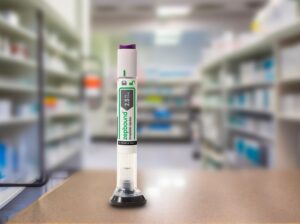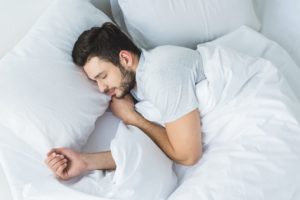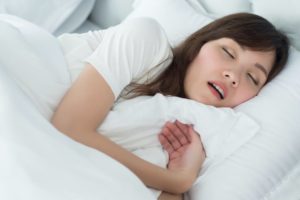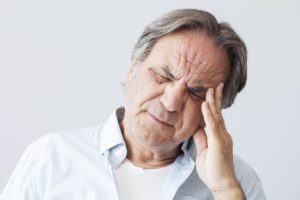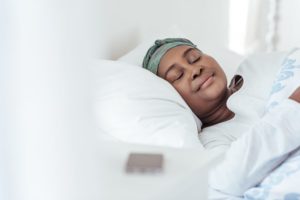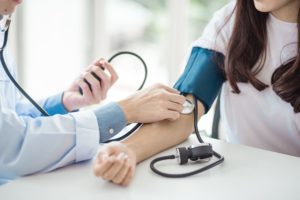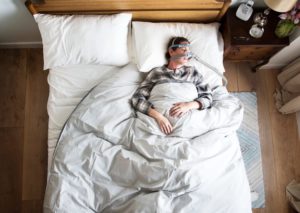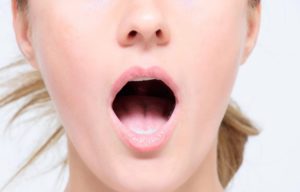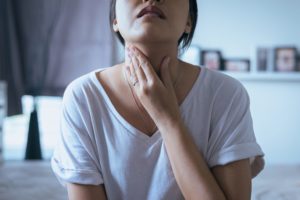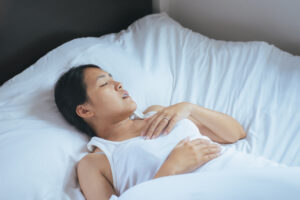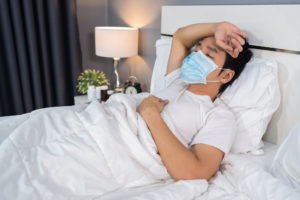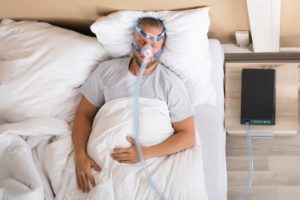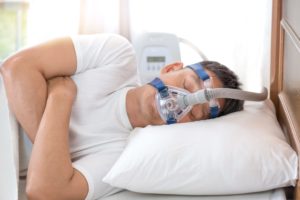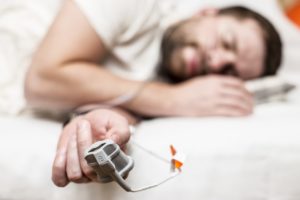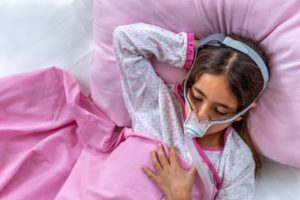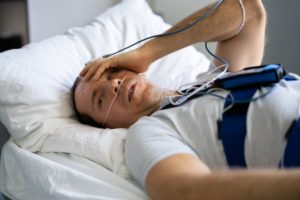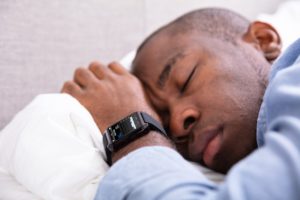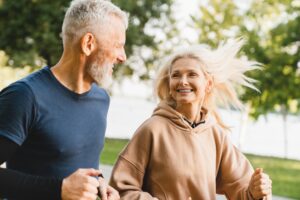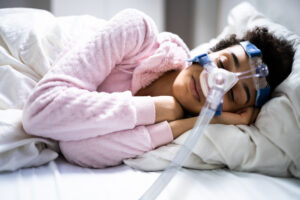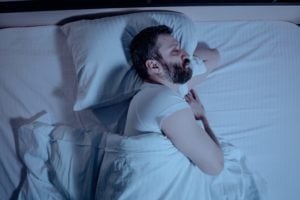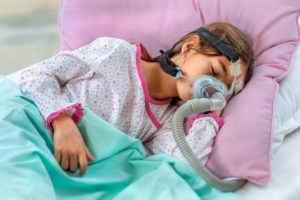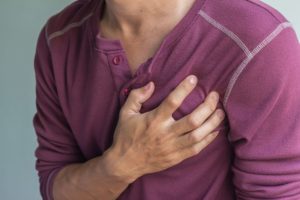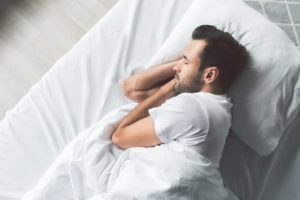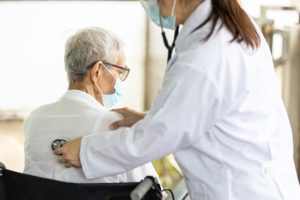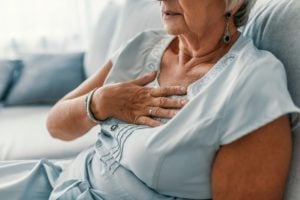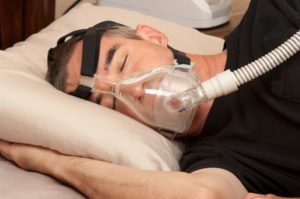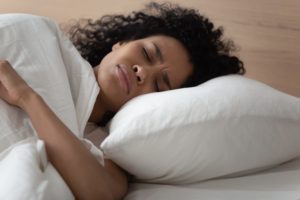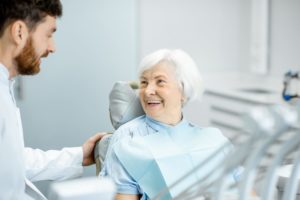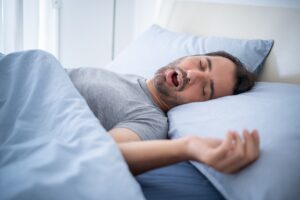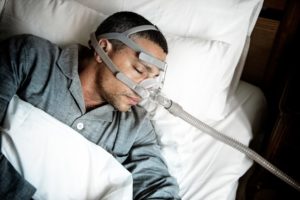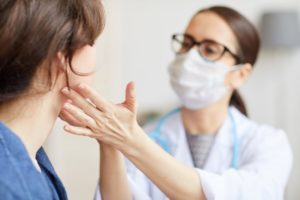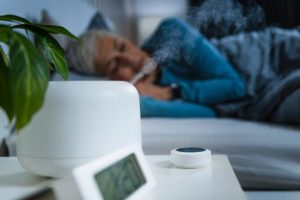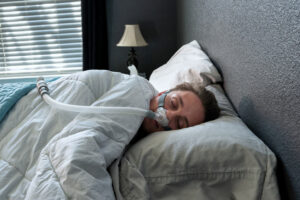When you buy through our links, we may earn a commission. Products or services may be offered by an affiliated entity. Learn more.
Cheyne-Stokes Respirations
Cheyne-Stokes respirations are a rare abnormal breathing pattern that can occur while awake but usually occurs during sleep. The pattern involves a period of fast, shallow breathing followed by slow, heavier breathing and moments without any breath at all, called apneas. Instead of an apnea, some people have periods of extremely shallow breathing, called hypopneas. After an apnea or hypopnea, the pattern begins again in a cycle that typically lasts 45 to 90 seconds.
Cheyne-Stokes breathing may be associated with central sleep apnea. Obstructive sleep apnea involves apneas caused by a physical blockage in the throat, usually relaxed muscle tissue, but central sleep apnea occurs when the body does not make the appropriate respiratory effort during sleep due to the absence of signals from the brain. Similarly, instability of respiratory control underlies the development of Cheyne-Stokes breathing. However, central sleep apnea and Cheyne-Stokes respirations impact respiratory effort in different ways.
Is Your Snoring a Health Risk?
Answer three questions to understand if you should be concerned.
Causes of Cheyne-Stokes Respirations
The most common causes of Cheyne-Stokes respirations are heart failure and stroke. Although considered to be rare, Cheyne-Stokes breathing occurs in 25% to 50% of people with heart failure. This breathing pattern appears to be less common in people who have suffered a stroke compared to those with heart failure, though factors like the involvement of a major artery or a cardioembolism may increase the risk .
In addition to heart failure and stroke, Cheyne-Stokes breathing is associated with:
- Arrival at a high altitude
- Brain injury or brain tumor
- High intracranial pressure
- Acute cardiogenic pulmonary edema
Cheyne-Stokes respirations are also a clinical sign seen in people who are in the process of dying .
Symptoms of Cheyne-Stokes Respirations
The main symptom of Cheyne-Stokes breathing is its characteristic crescendo-decrescendo breathing pattern. This pattern mostly occurs during sleep, particularly stage one and stage two non-REM sleep, but can also occur while awake. People who are asleep or on sedative medication are unlikely to be aware of their breathing pattern.
Cheyne-Stokes breathing tends to be worse when people sleep on their backs. People who have this condition experience at least five apneas or hypopneas a night, though they may experience many more.
Other symptoms associated with Cheyne-Stokes breathing include:
- Fatigue and excessive daytime sleepiness
- Difficult or labored breathing
- Loud snoring
- Sudden coughing fits
- Periodic limb movements during sleep

How Are Cheyne-Stokes Respirations Different From Similar Conditions That Affect Breathing?
Cheyne-Stokes breathing is only one condition that can affect the way you breathe while asleep or awake. Although different breathing conditions can share similarities, each is caused by unique factors and has distinct symptoms. If you are concerned about your breathing patterns or those of a loved one, it is important to speak to your doctor for diagnosis and treatment.
Central Sleep Apnea
Central sleep apnea and Cheyne-Stokes respirations are both caused by low respiratory effort and share many of the same symptoms, particularly excessive daytime sleepiness and loud snoring. However, central sleep apnea does not cause the characteristic Cheyne-Stokes breathing pattern, and the underlying cause of the low respiratory effort differs between the two conditions.
Kussmaul Breathing
Kussmaul breathing is a type of deep, rapid breathing that can be described as “air hunger” . Unlike Cheyne-Stokes breathing, Kussmaul breathing stays at one pace and does not include periods of slow breathing, apneas, or hypopneas. It also tends to occur while someone is awake. The most common cause of Kussmaul breathing is diabetic ketoacidosis, though it can also be caused by any disorder that causes a buildup of acid in the body.
Hypoventilation or Hyperventilation
Hypoventilation involves breathing too slowly or shallowly, while hyperventilation describes breathing too quickly or deeply. While Cheyne-Stokes breathing does include periods of both, its specific pattern of hyperventilation followed by hypoventilation with periodic apneas or hypopneas is unique. Both hyperventilation and hypoventilation can be caused by a wide range of conditions that may be either short-term or chronic.
Biot’s Respirations
Also known as ataxic breathing, Biot’s respirations are similar to Cheyne-Stokes respirations and are named after a man who studied both . A person with Biot’s respirations goes through periods of breathing very slowly or very quickly with occasional apneas. However, unlike Cheyne-Stokes breathing, ataxic breathing is very irregular and lacks a rising and falling pattern. Ataxic breathing is rarely described or reported in the literature, possibly due to most people now being intubated before it occurs.
Diagnosing Cheyne-Stokes Respirations
While diagnosing Cheyne-Stokes respirations that occur while awake is relatively easy due to their unique pattern, those that occur during sleep are often diagnosed using a sleep study called polysomnography. The symptoms of nighttime Cheyne-Stokes respirations are very similar to those of obstructive sleep apnea , making polysomnography an important step in ensuring that people with this condition receive the correct diagnosis and appropriate treatment.
Treatment for Cheyne-Stokes Respirations
The presence of Cheyne-Stokes respirations, particularly when someone is awake, can indicate a poor prognosis. This is partially because the breathing pattern can lead to a vicious cycle in which the low blood oxygen caused by apneas can further damage the heart or cause problems with its rhythm. Left untreated, Cheyne-Stokes respirations can cause changes in carbon dioxide levels that lead to death. Because of these concerns, Cheyne-Stokes respirations require treatment unless they are part of the expected death process.
The most important factor when treating Cheyne-Stokes breathing is managing what caused it, usually congestive heart failure or stroke. To treat the breathing problem itself, medical professionals may use both nighttime oxygen therapy and continuous positive airway pressure (CPAP) therapy. CPAP therapy is recommended by the American Academy of Sleep Medicine for Cheyne-Stokes. This type of therapy uses pressurized air to keep the airway open and encourage normal breathing. Oxygen therapy, on the other hand, provides people with a regular flow of oxygen while asleep. The mortality rate in people with Cheyne-Stokes respirations may be lower among some patients using CPAP therapy, while supplemental oxygen appears to improve their symptoms and overall quality of life.

Still have questions? Ask our community!
Join our Sleep Care Community — a trusted hub of sleep health professionals, product specialists, and people just like you. Whether you need expert sleep advice for your insomnia or you’re searching for the perfect mattress, we’ve got you covered. Get personalized guidance from the experts who know sleep best.
References
14 Sources
-
Kim, Y., Kim, S., Ryu, D. R., Lee, S. Y., & Im, K. B. (2018). Factors associated with Cheyne-Stokes respiration in acute ischemic stroke. Journal of Clinical Neurology (Seoul, Korea), 14(4), 542–548.
https://pubmed.ncbi.nlm.nih.gov/30198229/ -
Küpper, T., Schöffl, V., & Netzer, N. (2008). Cheyne Stokes breathing at high altitude: A helpful response or a troublemaker? Sleep & Breathing = Schlaf & Atmung, 12(2), 123–127.
https://pubmed.ncbi.nlm.nih.gov/18158610/ -
Carvalho, F. A., Bernardino, T., Maciel, R. O. H., Felizola, S. F. A., Costa, E. L. V., & Silva, G. S. (2011). Central neurogenic respiratory failure: A challenging diagnosis. Case Reports in Neurology, 3(1), 75–81.
https://pubmed.ncbi.nlm.nih.gov/21490717/ -
Eyster, J. A. (1906). Clinical and experimental observations upon cheyne-stokes respiration. The Journal of Experimental Medicine, 8(5), 565–613.
https://pubmed.ncbi.nlm.nih.gov/19867060/ -
Hoffman, R., Agatston, A., & Krieger, B. (1990). Cheyne-Stokes respiration in patients recovering from acute cardiogenic pulmonary edema. Chest, 97(2), 410–412.
https://pubmed.ncbi.nlm.nih.gov/2298068/ -
Hui, D., Dos Santos, R., Chisholm, G., Bansal, S., Souza Crovador, C., & Bruera, E. (2015). Bedside clinical signs associated with impending death in patients with advanced cancer: preliminary findings of a prospective, longitudinal cohort study. Cancer, 121(6), 960–967.
https://pubmed.ncbi.nlm.nih.gov/25676895/ -
Gallo de Moraes, A., & Surani, S. (2019). Effects of diabetic ketoacidosis in the respiratory system. World Journal of Diabetes, 10(1), 16–22.
https://pubmed.ncbi.nlm.nih.gov/30697367/ -
Minagar, A., & Weiner, W. J. (2001). Adolf Kussmaul and his respiratory sign. Journal of Medical Biography, 9(3), 181–183.
https://pubmed.ncbi.nlm.nih.gov/11466520/ -
Whited, L., & Graham, D. D. (2020, April 29). Abnormal respirations. StatPearls., Retrieved May 11, 2021, from
https://www.ncbi.nlm.nih.gov/books/NBK470309/ -
Brown, L. K. (2010). Hypoventilation syndromes. Clinics in Chest Medicine, 31(2), 249–270.
https://pubmed.ncbi.nlm.nih.gov/20488285/ -
Folgering, H. (1999). The pathophysiology of hyperventilation syndrome. Monaldi Archives for Chest Disease = Archivio Monaldi Per Le Malattie Del Torace, 54(4), 365–372.
https://pubmed.ncbi.nlm.nih.gov/10546483/ -
Wijdicks, E. F. M. (2007). Biot’s breathing. Journal of Neurology, Neurosurgery, and Psychiatry, 78(5), 512–513.
https://pubmed.ncbi.nlm.nih.gov/17435185/ -
Dowdell, W. T., Javaheri, S., & McGinnis, W. (1990). Cheyne-Stokes respiration presenting as sleep apnea syndrome. Clinical and polysomnographic features. The American Review of Respiratory Disease, 141(4 Pt 1), 871–879.
https://pubmed.ncbi.nlm.nih.gov/2327649/ -
Momomura, S. (2012). Treatment of Cheyne-Stokes respiration-central sleep apnea in patients with heart failure. Journal of Cardiology, 59(2), 110–116.
https://pubmed.ncbi.nlm.nih.gov/22370166/


